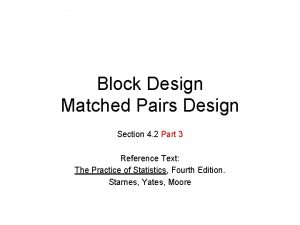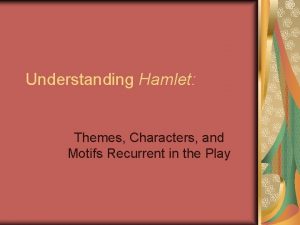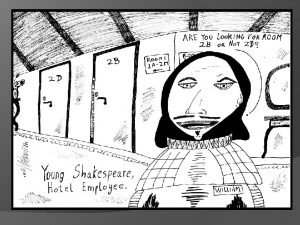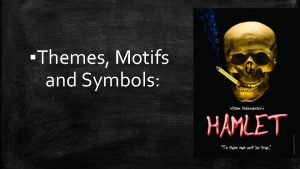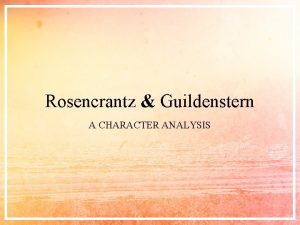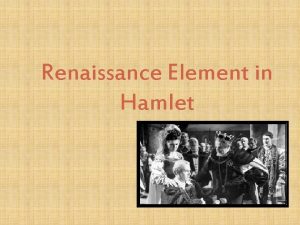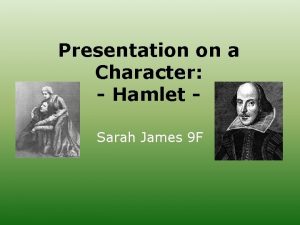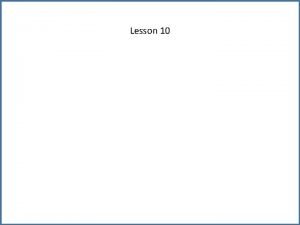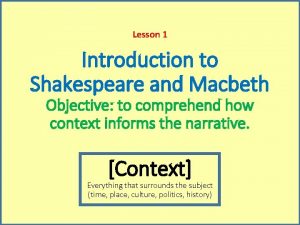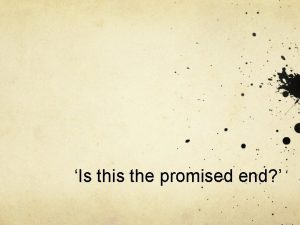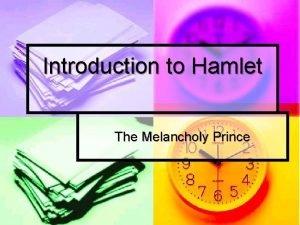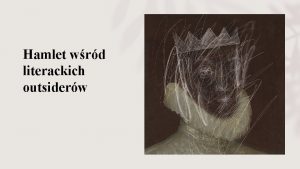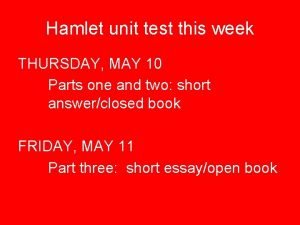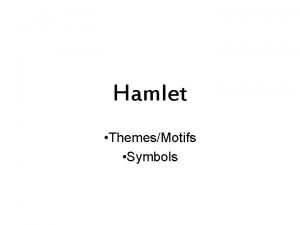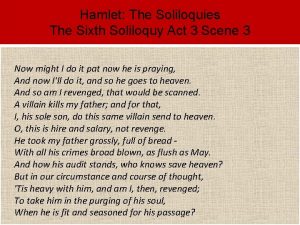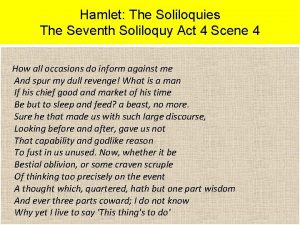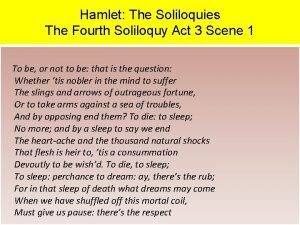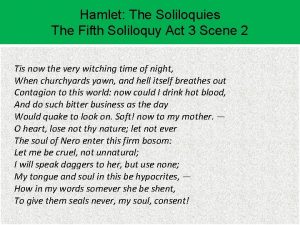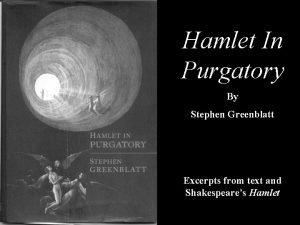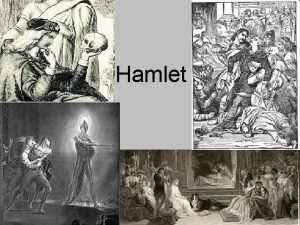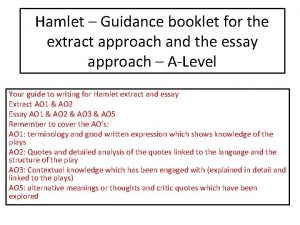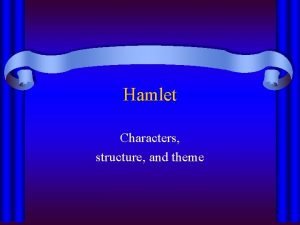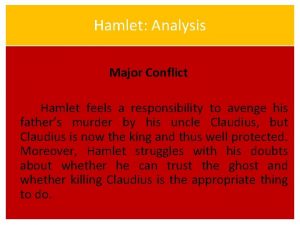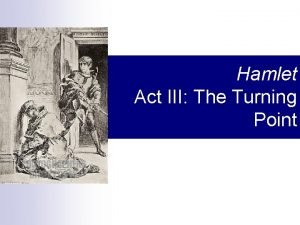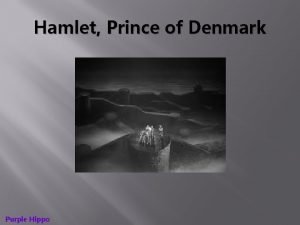mengxiaosdu edu cn Hamlet Nordri Design www nordridesign








































![Comparisons: metaphor • Examples: “[t]he slings and arrows of outrageous fortune, ” passively or Comparisons: metaphor • Examples: “[t]he slings and arrows of outrageous fortune, ” passively or](https://slidetodoc.com/presentation_image_h2/a9cebc36dcdf668417fc39d2d4213469/image-41.jpg)



![Monologue[‘mɔnəlɔɡ] 独白 • an extended speech uttered by one speaker, either to others or Monologue[‘mɔnəlɔɡ] 独白 • an extended speech uttered by one speaker, either to others or](https://slidetodoc.com/presentation_image_h2/a9cebc36dcdf668417fc39d2d4213469/image-45.jpg)
![Soliloquy [sə'liləkwi]独白;自言自语 • a dramatic speech delivered by one character speaking aloud while under Soliloquy [sə'liləkwi]独白;自言自语 • a dramatic speech delivered by one character speaking aloud while under](https://slidetodoc.com/presentation_image_h2/a9cebc36dcdf668417fc39d2d4213469/image-46.jpg)

































- Slides: 79

经典诵读(戏剧) 孟晓 mengxiao@sdu. edu. cn Hamlet 哈姆雷特 由Nordri. Design提供 www. nordridesign. com

To be or not to be, That is the question. 由Nordri. Design提供 www. nordridesign. com

Contents • • Shakespear’s life Shakespear’s works Hamlet Quotes www. nordridesign. com

• Born in a businessman family in 1564 • Very little is known about education background • Married to Anne Hathaway(8 years older than him) on November the 28 th, 1582 • Left hometown to London for living (20 years , one visit to hometown) • Began to write plays and poems • Back to hometwon in 1613 • Passed away in 1616 www. nordridesign. com

Shakespear’s House in Stratford-upon-Avon, England www. nordridesign. com

Written upon William Shakespeare’s tombstone • Good friend, for Jesus´ sake forbeare To digg the dust enclosed here! Blest be ye man that spares thes stones And curst be he that moues my bones. 看在上帝的面上, 请不要动我的坟墓, 妄动者将遭到诅咒, 保护者将受到祝福 www. nordridesign. com



感情基调:乐观、激越、明朗 四 大 喜 剧 作 品 《仲夏夜之梦》 A Midsummer Night‘s Dream 《皆大欢喜》 As You Like It 《第十二夜》 Twelfth Night 《威尼斯商人》 The Merchant of Venice www. nordridesign. com

莎士比亚环球剧院 www. nordridesign. com


《 》 仲 夏 夜 之 梦 www. nordridesign. com








Hamlet 哈姆雷特 www. nordridesign. com

The Plot overview • • • Ghost story Hamlet’s personal relation plight Test of murder story Hamlet’s exile Duel : Laertes vs. Hamlet Final revenge www. nordridesign. com

Hamlet Character Map www. nordridesign. com

Ghost • On a dark winter night, a ghost walks the ramparts of Elsinore Castle in Denmark. Discovered first by a pair of watchmen, then by the scholar Horatio, the ghost resembles the recently deceased King Hamlet, whose brother Claudius has inherited the throne and married the king’s widow, Queen Gertrude. When Horatio and the watchmen bring Prince Hamlet, the son of Gertrude and the dead king, to see the ghost, it speaks to him, declaring ominously that it is indeed his father’s spirit, and that he was murdered by none other than Claudius. Ordering Hamlet to seek revenge on the man who usurped his throne and married his wife, the ghost disappears with the dawn. Menu www. nordridesign. com

Hamlet’s personal relation plight • Prince Hamlet devotes himself to avenging his father’s death, but, because he is contemplative and thoughtful by nature, he delays, entering into a deep melancholy and even apparent madness. Claudius and Gertrude worry about the prince’s erratic behavior and attempt to discover its cause. They employ a pair of Hamlet’s friends, Rosencrantz and Guildenstern, to watch him. When Polonius, the pompous Lord Chamberlain, suggests that Hamlet may be mad with love for his daughter, Ophelia, Claudius agrees to spy on Hamlet in conversation with the girl. But though Hamlet certainly seems mad, he does not seem to love Ophelia: he orders her to enter a nunnery and declares that he wishes to ban marriages. Menu www. nordridesign. com

Test of Murder story • A group of traveling actors comes to Elsinore, and Hamlet seizes upon an idea to test his uncle’s guilt. He will have the players perform a scene closely resembling the sequence by which Hamlet imagines his uncle to have murdered his father, so that if Claudius is guilty, he will surely react. When the moment of the murder arrives in theater, Claudius leaps up and leaves the room. Hamlet and Horatio agree that this proves his guilt. Hamlet goes to kill Claudius but finds him praying. Since he believes that killing Claudius while in prayer would send Claudius’s soul to heaven, Hamlet considers that it would be an inadequate revenge and decides to wait. Menu www. nordridesign. com

Hamlet’s Exile • Claudius, now frightened of Hamlet’s madness and fearing for his own safety, orders that Hamlet be sent to England at once. Hamlet goes to confront his mother, in whose bedchamber Polonius has hidden behind a tapestry. Hearing a noise from behind the tapestry, Hamlet believes the king is hiding there. He draws his sword and stabs through the fabric, killing Polonius. www. nordridesign. com

• For this crime, he is immediately dispatched to England with Rosencrantz and Guildenstern. However, Claudius’s plan for Hamlet includes more than banishment, as he has given Rosencrantz and Guildenstern sealed orders for the King of England demanding that Hamlet be put to death. www. nordridesign. com

Duel Arranged • In the aftermath of her father’s death, Ophelia goes mad with grief and drowns in the river. Polonius’s son, Laertes, who has been staying in France, returns to Denmark in a rage. Claudius convinces him that Hamlet is to blame for his father’s and sister’s deaths. When Horatio and the king receive letters from Hamlet indicating that the prince has returned to Denmark after pirates attacked his ship en route to England, Claudius concocts a plan to use Laertes’ desire for revenge to secure Hamlet’s death. Laertes will fence with Hamlet in innocent sport, but Claudius will poison Laertes’ blade so that if he draws blood, Hamlet will die. www. nordridesign. com

Final revenge • The sword-fighting begins. Hamlet scores the first hit, but declines to drink from the king’s proffered goblet. Instead, Gertrude takes a drink from it and is swiftly killed by the poison. Laertes succeeds in wounding Hamlet, though Hamlet does not die of the poison immediately. First, Laertes is cut by his own sword’s blade, and, after revealing to Hamlet that Claudius is responsible for the queen’s death, he dies from the blade’s poison. Hamlet then stabs Claudius through with the poisoned sword and forces him to drink down the rest of the poisoned wine. Claudius dies, and Hamlet dies immediately after achieving his revenge. Menu www. nordridesign. com


www. nordridesign. com

www. nordridesign. com

soliloquy To be, or not to be: that is the question: Whether ’tis nobler in the mind to suffer The slings and arrows of outrageous fortune Or to take arms against a sea of troubles, And by opposing end them? To die, —to sleep, — No more; and by a sleep to say we end The heartache, and the thousand natural shocks That flesh is heir to, —’tis a consummation Devoutly to be wish’d. To die, —to sleep; — www. nordridesign. com

To sleep: perchance to dream: -ay, there’s the rub; For in that sleep of death what dreams may come, When we have shuffled off this mortal coil, Must give us pause: there’s the respect That makes calamity of so long life; For who would bear the whips and scorns of time, The oppressor’s wrong, the proud man’s contumely, The pangs of despis’d love, the law’s delay, The insolence of office, and the spurns That patient merit of the unworthy takes, When he himself might his quietus make With a bare bodkin? who would these fardels bear, www. nordridesign. com

To grunt and sweat under a weary life, But that the dread of something after death, — The undiscover’d country, from whose bourn No traveller returns, —puzzles the will, And makes us rather bear those ills we have Than fly to others that we know not of? Thus conscience does make cowards of us all; And thus the native hue of resolution Is sicklied o’er with the pale cast of thought; And enterprises of great pitch and moment, With this regard, their currents turn awry, And lose the name of action. (end) www. nordridesign. com

Questions: 1. “To be, or not to be” is the most famous line in English literature. What does it mean? Why are these words and what follows special? 2. what’s the main rhetorical devices in this soliloquy? 3. What are themes of this soliloquy? www. nordridesign. com

• “To be, or not to be, ” that is, to live or not to live. There are some other explanations. • It also means “to do nothing or fight back”, or “remain the same or change” and so on. As far as the context is concerned in this soliloquy, “to live or not to live” can be more persuasive. Back www. nordridesign. com

• One reason is that they are a stunning example of Shakespeare’s ability to make his characters seem three-dimensional. The audience senses that there is more to Hamlet’s words than meets the ear—that there is something behind his words that is never spoken. Or, to put it another way, the audience witnesses signs of something within Hamlet’s mind that even he isn’t aware of. Hamlet is a fictional character who seems to possess a subconscious mind. Next page www. nordridesign. com

• Hamlet doesn’t talk directly about what he’s really talking about. When he questions whether it is better “to be, or not to be, ” the obvious implication is, “Should I kill myself? ” The entire soliloquy strongly suggests that he is toying with suicide and perhaps trying to work up his courage to do it. But at no point does he say that he is in pain or discuss why he wants to kill himself. Next page www. nordridesign. com

• In fact, he never says “I” or “me” in the entire speech. He’s not trying to “express” himself at all; instead, he poses the question as a matter of philosophical debate. When he claims that everybody would commit suicide if they weren’t uncertain about the afterlife, it sounds as if he’s making an argument to convince an imaginary listener about an abstract point rather than directly addressing how the question applies to him. www. nordridesign. com
![Comparisons metaphor Examples the slings and arrows of outrageous fortune passively or Comparisons: metaphor • Examples: “[t]he slings and arrows of outrageous fortune, ” passively or](https://slidetodoc.com/presentation_image_h2/a9cebc36dcdf668417fc39d2d4213469/image-41.jpg)
Comparisons: metaphor • Examples: “[t]he slings and arrows of outrageous fortune, ” passively or to actively seek to end one’s suffering? • He compares death to sleep and thinks of the end to suffering, pain, and uncertainty it might bring, “[t]he heartache, and the thousand natural shocks / That flesh is heir to. ” www. nordridesign. com

Parallelism: • “For who would bear the whips and scorns of time, The oppressor’s wrong, the proud man’s contumely, The pangs of despis’d love, the law’s delay, The insolence of office, and the spurns That patient merit of the unworthy takes” Back www. nordridesign. com

Themes of this soliloquy • this speech connects many of the play’s main themes, including the idea of suicide and death, the difficulty of knowing the truth in a spiritually ambiguous universe, and the connection between thought and action. • In addition to its crucial thematic content, this speech is important for what it reveals about the quality of Hamlet’s mind. His deeply passionate nature is complemented by a relentlessly logical intellect, which works furiously to find a solution to his misery. He has turned to religion and found it inadequate to help him either kill himself or resolve to kill Claudius. Here, he turns to a logical philosophical inquiry and finds it equally frustrating. Back www. nordridesign. com

Tragedy • a serious play or novel representing the disastrous downfall of a central character, the protagonist. According to Aristotle, the purpose is to achieve a catharsis through incidents arousing pity and terror. The tragic effect usually depends on our awareness of admirable qualities in the protagonist, which are wasted terribly in the fated disaster. www. nordridesign. com
![Monologuemɔnəlɔɡ 独白 an extended speech uttered by one speaker either to others or Monologue[‘mɔnəlɔɡ] 独白 • an extended speech uttered by one speaker, either to others or](https://slidetodoc.com/presentation_image_h2/a9cebc36dcdf668417fc39d2d4213469/image-45.jpg)
Monologue[‘mɔnəlɔɡ] 独白 • an extended speech uttered by one speaker, either to others or alone. Significant varieties include the dramatic monologue (a kind of poem in which the speaker is imagined to be addressing a silent audience), and the soliloquy (in which the speaker is supposed to be “overheard” while alone). 独白 www. nordridesign. com
![Soliloquy səliləkwi独白自言自语 a dramatic speech delivered by one character speaking aloud while under Soliloquy [sə'liləkwi]独白;自言自语 • a dramatic speech delivered by one character speaking aloud while under](https://slidetodoc.com/presentation_image_h2/a9cebc36dcdf668417fc39d2d4213469/image-46.jpg)
Soliloquy [sə'liləkwi]独白;自言自语 • a dramatic speech delivered by one character speaking aloud while under the impression of being alone. The soliloquist thus reveals his or her inner thoughts and feelings to the audience, either in supposed selfcommunion or in a consciously direct address. It is also known as interior monologue. 内心独白 www. nordridesign. com

Analysis of Hamlet the character 1. enigmatic 2. philosophical and contemplative 3. rash and impulsive 4. melancholy and discontented 5. personal and philosophical concerns www. nordridesign. com

Analysis of the Character of Hamlet 1. Hamlet is enigmatic. Hamlet actually tells other characters that there is more to him than meets the eye—notably, his mother, and Rosencrantz and Guildenstern—but his fascination involves much more than this. When he speaks, he sounds as if there’s something important he’s not saying, maybe something even he is not aware of. The ability to write soliloquies and dialogues that create this effect is one of Shakespeare’s most impressive achievements. www. nordridesign. com

• 2. Hamlet is extremely philosophical and contemplative. He is particularly drawn to difficult questions or questions that cannot be answered with any certainty. Faced with evidence that his uncle murdered his father, evidence that any other character in a play would believe, Hamlet becomes obsessed with proving his uncle’s guilt before trying to act. The standard of “beyond a reasonable doubt” is simply unacceptable to him. He is equally plagued with questions about the afterlife, about the wisdom of suicide, about what happens to bodies after they die—the list is extensive. www. nordridesign. com

3. Hamlet also behaves rashly and impulsively. When he does act, it is with surprising swiftness and little or no premeditation, as when he stabs Polonius through a curtain without even checking to see who he is. He seems to step very easily into the role of a madman, behaving erratically(不规律 的 ) and upsetting the other characters with his wild speech and pointed innuendos(影射,暗讽). www. nordridesign. com

• 4. Hamlet is extremely melancholy and discontented with the state of affairs in Denmark and in his own family—indeed, in the world at large. He is extremely disappointed with his mother for marrying his uncle so quickly, and he repudiates Ophelia, a woman he once claimed to love, in the harshest terms. His words often indicate his disgust with and distrust of women in general. At a number of points in the play, he contemplates his own death and even the option of suicide. www. nordridesign. com

5. But, despite all of the things with which Hamlet professes dissatisfaction, it is remarkable that the prince and apparent heir of Denmark should think about these problems only in personal and philosophical terms. He spends relatively little time thinking about the threats to Denmark’s national security from without or the threats to its stability from within (some of which he helps to create through his own carelessness). www. nordridesign. com

Shakespear’s quotes www. nordridesign. com


《仲夏夜之梦》(1595 -1596) A Midsummer Night’s Dream www. nordridesign. com

《温莎的风流娘儿们》(1598 -1601) The Merry Wives of Windsor www. nordridesign. com

《第十二夜》 Twelfth Night (1599 -1600) www. nordridesign. com

威尼斯商人 Bassanio and Portia www. nordridesign. com

朱丽叶 www. nordridesign. com

罗密欧与朱丽叶 返回 www. nordridesign. com

奥赛罗 The Meeting of Othello and Desdemona www. nordridesign. com

李尔王 King Lear and the Fool in the Storm www. nordridesign. com

麦克白 The Three Witches www. nordridesign. com

暴风雨 The Tempest 返回 www. nordridesign. com

暴风雨 Ariel www. nordridesign. com

哈姆雷特 The Young Lord Hamlet www. nordridesign. com

哈姆雷特 Ophelia www. nordridesign. com

哈姆雷特 Hamlet and the Ghost www. nordridesign. com

戏中戏 www. nordridesign. com

雅典的泰门 Timon and Apemantus www. nordridesign. com

Come Unto These Yellow Sands www. nordridesign. com

莎士比亚铜像 www. nordridesign. com

伊丽莎白时代典型剧场 www. nordridesign. com

莎士比亚故居和签名 www. nordridesign. com

奥赛罗封面 www. nordridesign. com

《请君入瓮》 www. nordridesign. com


感谢您的关注 www. nordridesign. com

 Answer the following questions
Answer the following questions Edu.sharif.edu
Edu.sharif.edu Viscom design process
Viscom design process Input output form design in system analysis and design
Input output form design in system analysis and design What is a decorative design
What is a decorative design Structural and decorative design
Structural and decorative design Counterbalancing
Counterbalancing Process design and control design should always be in
Process design and control design should always be in Between vs within subjects
Between vs within subjects Between-subjects design vs within
Between-subjects design vs within Matched pair design vs block design
Matched pair design vs block design User interface design in system analysis and design
User interface design in system analysis and design Matched pairs vs block design
Matched pairs vs block design Principles of design in interior design ppt
Principles of design in interior design ppt Examples of bad design
Examples of bad design Anova repeated measures
Anova repeated measures Dialogue design
Dialogue design Greek floral design
Greek floral design Difference between service and product
Difference between service and product Libidau
Libidau Design brief problem statement
Design brief problem statement William shakespeare 1601
William shakespeare 1601 Hamlet dramski trikotnik
Hamlet dramski trikotnik Prijevoditelj
Prijevoditelj Hamlet themes and motifs
Hamlet themes and motifs Act 3 scene 1 hamlet
Act 3 scene 1 hamlet Motifs in hamlet
Motifs in hamlet Hamlet plot
Hamlet plot Hamlet the lion king
Hamlet the lion king Lion king hamlet
Lion king hamlet Hamlet introduction
Hamlet introduction Themes of hamlet
Themes of hamlet Rosencrantz and guildenstern analysis
Rosencrantz and guildenstern analysis Shakespeare cheat sheet
Shakespeare cheat sheet Hamlet renaissance
Hamlet renaissance Pun in hamlet
Pun in hamlet Prince hamlet
Prince hamlet Hamlet characteristics
Hamlet characteristics Major characters in hamlet
Major characters in hamlet Macbeth act 5 scene 2 analysis
Macbeth act 5 scene 2 analysis Introduction to macbeth
Introduction to macbeth Prologue hamlet
Prologue hamlet The simpsons hamlet
The simpsons hamlet Dull revenge meaning
Dull revenge meaning Hamlet character analysis
Hamlet character analysis Wartości wyznawane przez hamleta
Wartości wyznawane przez hamleta Hamlet pitanja i odgovori
Hamlet pitanja i odgovori The tragedy of hamlet unit test
The tragedy of hamlet unit test Hamlet tone
Hamlet tone Symbols in hamlet
Symbols in hamlet 6th soliloquy hamlet
6th soliloquy hamlet Hamlet seventh soliloquy
Hamlet seventh soliloquy Hamlets fourth soliloquy
Hamlets fourth soliloquy Hamlet soliquoy
Hamlet soliquoy Hamlet 5 soliloquies
Hamlet 5 soliloquies Hamlet was written by william shakespeare
Hamlet was written by william shakespeare Hamlet soliloquy act 2
Hamlet soliloquy act 2 Hamlet act 1 scene 2
Hamlet act 1 scene 2 Hamlet act 4 and 5 quiz
Hamlet act 4 and 5 quiz Hamlet socratic seminar questions
Hamlet socratic seminar questions Hamlet journal prompts
Hamlet journal prompts Hamlet journal entries
Hamlet journal entries Hamlet genre
Hamlet genre Ghost cries purgatorium
Ghost cries purgatorium Hamlet explication
Hamlet explication Hamlet booklet
Hamlet booklet Hamlet soundtrack project
Hamlet soundtrack project Rebecca smith hamlet
Rebecca smith hamlet Subplot in hamlet
Subplot in hamlet Themes in hamlet act 2
Themes in hamlet act 2 Hamlet character foils
Hamlet character foils Motifs in hamlet
Motifs in hamlet Plot synopsis of hamlet
Plot synopsis of hamlet Major conflict in hamlet
Major conflict in hamlet Hamlet alphabet
Hamlet alphabet Ophelia tells her father in scene i that hamlet is behaving
Ophelia tells her father in scene i that hamlet is behaving What is hamlet about
What is hamlet about Where did hamlet hide polonius body
Where did hamlet hide polonius body What is the turning point in act 3 of hamlet
What is the turning point in act 3 of hamlet Hamlet act 2 scene 1 summary
Hamlet act 2 scene 1 summary










